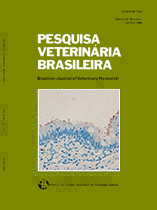 |
|
|
|
Year 2017 - Volume 37, Number 10
|

|
Epidemiology of visceral leishmaniasis in Fortaleza, Ceará, Brazil, 37(10):1119-1124
|
ABSTRACT.- Rodrigues A.C.M., Melo A.C.F.L., Júnior A.D.S., Franco S.O., Rondon F.C.M. & Bevilaqua C.M.L. 2017. [Epidemiology of visceral leishmaniasis in Fortaleza, Ceará, Brazil.] Epidemiologia da leishmaniose visceral no município de Fortaleza, Ceará. Pesquisa Veterinária Brasileira 37(10):1119-1124. Programa de Pós-Graduação em Ciências Veterinárias, Universidade Estadual do Ceará, Av. Dr. Silas Munguba 1700, Campus Itaperi, Fortaleza, CE 60714-903, Brazil. E-mail: bevilaqua.uece@gmail.com
The objective was to analyze the data relating to the transmission of visceral leishmaniasis (LV) in Fortaleza municipality, and discuss about the vector distribution, domestic reservoir and human cases from 2009 to 2013.This study is descriptive conducted through a survey of secondary data. The correlation between human and canine cases and sandflies number was taken by Spearman correlation test, with 5% significance level. In the period 2009 to 2013, 941 cases and 55 deaths were confirmed. The mortality rate for the period was 5.84%. There was a higher proportion of cases among men in all the years analyzed. The age group 1-4 years old had the highest percentage of cases, highlighting the year 2010 with 31.5% of the cases. The average distribution of cases by SER demonstrated a predominance in SER I, V and VI. With regard to the vector species found in greater abundance was Lutzomyia (Lutzomyia) longipalpis, followed by Lutzomyia (Lutzomyia) migonei and Lutzomyia (Lutzomyia) lenti. According to the records, 39,626 dogs were serum reagents for LV in the years 2009-2013, these 14,313 were killed. The year 2013 stood out with 17,808 dogs serum reagents, and 1,273 of SER III, 2572 of SER V and 1909 of SER VI. There was no significant correlation between the number of sand flies and the number of canine VL cases (p>0.05). There was a negative correlation between human and canine cases (r = -0.0388) and correlation was observed between human cases and number of sand flies (r= 0.7469).Our findings create prospects for the identification of other factors that may influence the incidence of human and canine cases, such as the participation of other possible reservoirs and vectors in the transmission of the visceral leishmaniasis in Fortaleza. |
| |
|
|
| |
|
 |